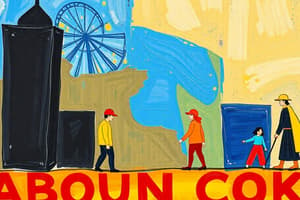Podcast
Questions and Answers
What can happen if a hazard cannot be corrected or protected against?
What can happen if a hazard cannot be corrected or protected against?
- Employees will be penalized.
- The issue will be ignored.
- A stop-work order may be issued. (correct)
- A warning will be issued.
Which group is prohibited from taking action against employees who refuse dangerous work?
Which group is prohibited from taking action against employees who refuse dangerous work?
- Coworkers
- Safety inspectors
- Regulatory bodies
- Employers (correct)
What is the maximum fine for violating part II of the CLC?
What is the maximum fine for violating part II of the CLC?
- $250,000
- $2 million
- $1 million (correct)
- $500,000
What is the primary purpose of certification for a union?
What is the primary purpose of certification for a union?
What must senior management ensure to demonstrate due diligence?
What must senior management ensure to demonstrate due diligence?
What must an applicant union demonstrate to the CIRB for certification?
What must an applicant union demonstrate to the CIRB for certification?
Which of the following roles is specifically mentioned for having responsibilities related to hazard prevention programs?
Which of the following roles is specifically mentioned for having responsibilities related to hazard prevention programs?
What happens if a union's application shows support from 35% to 50% of employees?
What happens if a union's application shows support from 35% to 50% of employees?
What can managers use as a defense if charged under the CLC?
What can managers use as a defense if charged under the CLC?
What is a responsibility of middle management in the context of workplace safety?
What is a responsibility of middle management in the context of workplace safety?
Why might employees choose to unionize?
Why might employees choose to unionize?
What must senior managers do when made aware of serious situations?
What must senior managers do when made aware of serious situations?
What is the minimum number of times the WHSC is required to meet each year?
What is the minimum number of times the WHSC is required to meet each year?
What is one of the benefits of certification for employees?
What is one of the benefits of certification for employees?
How does a union gain support from employees in the bargaining unit?
How does a union gain support from employees in the bargaining unit?
In a workplace with fewer than 20 employees, who is required to be appointed?
In a workplace with fewer than 20 employees, who is required to be appointed?
What activities may a health and safety representative be involved in?
What activities may a health and safety representative be involved in?
What does the outcome of a secret ballot vote depend on?
What does the outcome of a secret ballot vote depend on?
Which action can certified employees use to strengthen their negotiating position?
Which action can certified employees use to strengthen their negotiating position?
What action may an employee take if they believe their work poses a health risk?
What action may an employee take if they believe their work poses a health risk?
What happens if the employee and supervisor do not agree on a complaint?
What happens if the employee and supervisor do not agree on a complaint?
What can an investigator appointed by the minister do during an investigation?
What can an investigator appointed by the minister do during an investigation?
What protection does an employee have when filing a complaint?
What protection does an employee have when filing a complaint?
What is not a responsibility of a health and safety representative?
What is not a responsibility of a health and safety representative?
What is the significance of the 'new labour trilogy' in Canadian labour law?
What is the significance of the 'new labour trilogy' in Canadian labour law?
Which section of the Charter did the Supreme Court interpret to introduce a constitutional 'right to strike'?
Which section of the Charter did the Supreme Court interpret to introduce a constitutional 'right to strike'?
What assumption about employees and managers is challenged in the ongoing case related to Quebec’s Labour Code?
What assumption about employees and managers is challenged in the ongoing case related to Quebec’s Labour Code?
In what year did the Supreme Court address issues in the 'new labour trilogy'?
In what year did the Supreme Court address issues in the 'new labour trilogy'?
Which case from the 'new labour trilogy' had the most far-reaching effects?
Which case from the 'new labour trilogy' had the most far-reaching effects?
How do North American labour codes, including Quebec’s, typically define the relationship between employees and management?
How do North American labour codes, including Quebec’s, typically define the relationship between employees and management?
What legal action is being examined regarding first-level casino managers in Quebec?
What legal action is being examined regarding first-level casino managers in Quebec?
Which historical act influenced the basis for most North American labour codes?
Which historical act influenced the basis for most North American labour codes?
What documentation is an employee required to provide when taking a leave due to health circumstances?
What documentation is an employee required to provide when taking a leave due to health circumstances?
During maternity leave, what financial support do employees typically receive?
During maternity leave, what financial support do employees typically receive?
How long can an employee take a maternity leave for a normal pregnancy?
How long can an employee take a maternity leave for a normal pregnancy?
What happens to an employee's pension benefits while they are on leave?
What happens to an employee's pension benefits while they are on leave?
Which of the following statements is true regarding leave for the hospitalization of a newborn?
Which of the following statements is true regarding leave for the hospitalization of a newborn?
What is required from an employee before taking a leave of absence?
What is required from an employee before taking a leave of absence?
What must an employer do regarding the position of an employee who takes a leave?
What must an employer do regarding the position of an employee who takes a leave?
How long can parental leave be taken after the birth or adoption of a child?
How long can parental leave be taken after the birth or adoption of a child?
What is the primary responsibility of employers when there are inherent dangers in the workplace?
What is the primary responsibility of employers when there are inherent dangers in the workplace?
Which situation would NOT support a work refusal under the CLC?
Which situation would NOT support a work refusal under the CLC?
How is 'danger' defined by the CLC?
How is 'danger' defined by the CLC?
What special provision exists for pregnant and nursing employees concerning work refusal?
What special provision exists for pregnant and nursing employees concerning work refusal?
In the context of workplace conflict or bullying, how is this viewed under the definition of danger?
In the context of workplace conflict or bullying, how is this viewed under the definition of danger?
What role does the condition or health of an employee play in determining danger?
What role does the condition or health of an employee play in determining danger?
What must an employee do to establish a perceived risk while on the job?
What must an employee do to establish a perceived risk while on the job?
How should dangers be approached in various employment circumstances, according to the CLC?
How should dangers be approached in various employment circumstances, according to the CLC?
The LRRBE's activities are characterized as essential to the federal powers over Indians and lands reserved for Indians.
The LRRBE's activities are characterized as essential to the federal powers over Indians and lands reserved for Indians.
The adjudicator allowed the application and proceeded with the hearing.
The adjudicator allowed the application and proceeded with the hearing.
Decisions made by adjudicators applying the CLC are equally persuasive in other jurisdictions.
Decisions made by adjudicators applying the CLC are equally persuasive in other jurisdictions.
The Canada Labour Code aims to promote conflict between the needs of employers and employees.
The Canada Labour Code aims to promote conflict between the needs of employers and employees.
The CLC is similar to the Canadian Charter of Rights and Freedoms in its requirements for provincial legislation.
The CLC is similar to the Canadian Charter of Rights and Freedoms in its requirements for provincial legislation.
The adjudicator found the LRRBE to be a federal undertaking.
The adjudicator found the LRRBE to be a federal undertaking.
The application regarding the LRRBE was dismissed by the adjudicator.
The application regarding the LRRBE was dismissed by the adjudicator.
The section of the Canada Labour Code regarding industrial relations outlines employer and employee responsibilities.
The section of the Canada Labour Code regarding industrial relations outlines employer and employee responsibilities.
An employer must give 48 hours’ notice of a lockout before proceeding.
An employer must give 48 hours’ notice of a lockout before proceeding.
A union can strike if they have not conducted a secret ballot vote in the last 60 days.
A union can strike if they have not conducted a secret ballot vote in the last 60 days.
Replacement workers can be hired by employers during a strike or lockout for legitimate bargaining purposes.
Replacement workers can be hired by employers during a strike or lockout for legitimate bargaining purposes.
The Supreme Court of Canada has established that the right to strike is not protected by the Charter.
The Supreme Court of Canada has established that the right to strike is not protected by the Charter.
Employers can discontinue pension benefits during a strike as long as they inform the bargaining agent.
Employers can discontinue pension benefits during a strike as long as they inform the bargaining agent.
During a strike or lockout, services that could jeopardize public health do not have to be maintained.
During a strike or lockout, services that could jeopardize public health do not have to be maintained.
Employees who refuse to perform the work of a striking worker can be disciplined by their employer.
Employees who refuse to perform the work of a striking worker can be disciplined by their employer.
The majority of the union must approve a strike for it to take place legally.
The majority of the union must approve a strike for it to take place legally.
The CIRB can only impose fines as a remedial action for unfair labour practices.
The CIRB can only impose fines as a remedial action for unfair labour practices.
Employers are required to eliminate hazards to prevent workplace injuries according to the CLC.
Employers are required to eliminate hazards to prevent workplace injuries according to the CLC.
If a hazard cannot be eliminated, the next step is providing personal protective equipment.
If a hazard cannot be eliminated, the next step is providing personal protective equipment.
Specific regulations like the Coal Mining Occupational Health and Safety Regulations are not part of the CLC.
Specific regulations like the Coal Mining Occupational Health and Safety Regulations are not part of the CLC.
The right to strike is protected by the Charter of Rights and Freedoms in Canada.
The right to strike is protected by the Charter of Rights and Freedoms in Canada.
An employee can initiate a formal investigation if they believe the work environment is safe.
An employee can initiate a formal investigation if they believe the work environment is safe.
The Supreme Court of Canada's ruling on the right to strike was decided unanimously.
The Supreme Court of Canada's ruling on the right to strike was decided unanimously.
Remedial actions for unfair labour practices can include awarding a salary increment to affected employees.
Remedial actions for unfair labour practices can include awarding a salary increment to affected employees.
The Canada Labour Code has no provisions related to worker safety in the aviation industry.
The Canada Labour Code has no provisions related to worker safety in the aviation industry.
Justice Abella argued that the law should maintain an equal power balance between employers and employees in labor relations.
Justice Abella argued that the law should maintain an equal power balance between employers and employees in labor relations.
The law allows the government to classify certain workers as 'essential' without any implications on their right to strike.
The law allows the government to classify certain workers as 'essential' without any implications on their right to strike.
The purpose of part II of the CLC is solely to regulate unfair labour practices.
The purpose of part II of the CLC is solely to regulate unfair labour practices.
The Supreme Court's previous view was that the Charter did not protect collective bargaining.
The Supreme Court's previous view was that the Charter did not protect collective bargaining.
The Saskatchewan Federation of Labour case was decided with a ruling that supports extensive limitations on the right to strike.
The Saskatchewan Federation of Labour case was decided with a ruling that supports extensive limitations on the right to strike.
Canada's international obligations support the right to strike.
Canada's international obligations support the right to strike.
In the context of labor relations, big changes occur regularly with little prior indication.
In the context of labor relations, big changes occur regularly with little prior indication.
Employers are required to minimize risks through all reasonable and practical measures in high-risk occupations.
Employers are required to minimize risks through all reasonable and practical measures in high-risk occupations.
Work refusals are supported when employees face risks that are normally part of their job.
Work refusals are supported when employees face risks that are normally part of their job.
The definition of 'danger' by the CLC is narrowly defined to apply only to physical hazards.
The definition of 'danger' by the CLC is narrowly defined to apply only to physical hazards.
Pregnant and nursing employees can refuse work if they perceive any risk to their health or their child's health.
Pregnant and nursing employees can refuse work if they perceive any risk to their health or their child's health.
Individual worker health conditions do not affect the assessment of danger in the workplace.
Individual worker health conditions do not affect the assessment of danger in the workplace.
Circumstances of workplace conflict or bullying are considered as forms of danger under the CLC.
Circumstances of workplace conflict or bullying are considered as forms of danger under the CLC.
An employee must consult with a medical practitioner only when they believe a task poses a risk to themselves.
An employee must consult with a medical practitioner only when they believe a task poses a risk to themselves.
Employers are permitted to ignore risks that are inherent to specific job roles.
Employers are permitted to ignore risks that are inherent to specific job roles.
The maximum aggregate leave for parental leave that can be taken for the same birth is 86 weeks.
The maximum aggregate leave for parental leave that can be taken for the same birth is 86 weeks.
Compassionate care leave allows employees to take up to 21 weeks to support a family member with a serious medical condition.
Compassionate care leave allows employees to take up to 21 weeks to support a family member with a serious medical condition.
An employee can take critical illness leave for a child that is critically ill for a period of 52 weeks.
An employee can take critical illness leave for a child that is critically ill for a period of 52 weeks.
If a child has disappeared under circumstances suggesting a crime, parents are eligible for compassionate leave.
If a child has disappeared under circumstances suggesting a crime, parents are eligible for compassionate leave.
A medical certificate is not required when taking critical illness leave for a child.
A medical certificate is not required when taking critical illness leave for a child.
The maximum maternity leave an employee can take for a normal pregnancy is 78 weeks.
The maximum maternity leave an employee can take for a normal pregnancy is 78 weeks.
Employees are entitled to a maximum of 104 weeks of leave if special medical circumstances exist.
Employees are entitled to a maximum of 104 weeks of leave if special medical circumstances exist.
Family members eligible for compassionate care leave include only the employee's spouse and children.
Family members eligible for compassionate care leave include only the employee's spouse and children.
Flashcards
Union Certification
Union Certification
A process where an independent body (CIRB) verifies that a majority of employees in a workplace want to be represented by a union. This gives the union the right to negotiate with the employer on behalf of the employees.
Bargaining Unit
Bargaining Unit
A group of employees in a workplace who share similar work duties and are eligible to be represented by a union.
Union Membership Cards
Union Membership Cards
Signed documents where employees express their desire to be represented by a union.
Secret Ballot Vote
Secret Ballot Vote
Signup and view all the flashcards
Collective Bargaining
Collective Bargaining
Signup and view all the flashcards
Economic Sanctions
Economic Sanctions
Signup and view all the flashcards
Reasons for Unionization
Reasons for Unionization
Signup and view all the flashcards
Benefits of Unionization
Benefits of Unionization
Signup and view all the flashcards
Stop-Work Order
Stop-Work Order
Signup and view all the flashcards
Employee Protection under CLC
Employee Protection under CLC
Signup and view all the flashcards
Reasonable Care and Due Diligence
Reasonable Care and Due Diligence
Signup and view all the flashcards
Senior Management Responsibilities
Senior Management Responsibilities
Signup and view all the flashcards
Written Safety Policies
Written Safety Policies
Signup and view all the flashcards
Middle Management Responsibilities
Middle Management Responsibilities
Signup and view all the flashcards
Giving and Monitoring Instructions
Giving and Monitoring Instructions
Signup and view all the flashcards
Relying on Safety Systems
Relying on Safety Systems
Signup and view all the flashcards
Workplace Health and Safety Committee (WHSC)
Workplace Health and Safety Committee (WHSC)
Signup and view all the flashcards
Health and Safety Representative
Health and Safety Representative
Signup and view all the flashcards
Complaint Resolution
Complaint Resolution
Signup and view all the flashcards
Right to Refuse Unsafe Work
Right to Refuse Unsafe Work
Signup and view all the flashcards
Employee Complaint
Employee Complaint
Signup and view all the flashcards
Investigator
Investigator
Signup and view all the flashcards
Investigation
Investigation
Signup and view all the flashcards
Protection from Retaliation
Protection from Retaliation
Signup and view all the flashcards
Maternity Leave
Maternity Leave
Signup and view all the flashcards
Parental Leave
Parental Leave
Signup and view all the flashcards
Pregnancy Accommodation
Pregnancy Accommodation
Signup and view all the flashcards
Pregnancy Leave
Pregnancy Leave
Signup and view all the flashcards
Maternity Leave Duration
Maternity Leave Duration
Signup and view all the flashcards
Parental Leave Duration
Parental Leave Duration
Signup and view all the flashcards
Shared Parental Leave
Shared Parental Leave
Signup and view all the flashcards
Job Security During Leave
Job Security During Leave
Signup and view all the flashcards
Danger in Workplace
Danger in Workplace
Signup and view all the flashcards
Employer's Duty to Minimize Risk
Employer's Duty to Minimize Risk
Signup and view all the flashcards
Work Refusal
Work Refusal
Signup and view all the flashcards
CLC's Definition of Danger
CLC's Definition of Danger
Signup and view all the flashcards
Individualized Approach to Danger
Individualized Approach to Danger
Signup and view all the flashcards
Special Provisions for Pregnant/Nursing Employees
Special Provisions for Pregnant/Nursing Employees
Signup and view all the flashcards
Tryggvason Case
Tryggvason Case
Signup and view all the flashcards
Workplace Conflict as Danger
Workplace Conflict as Danger
Signup and view all the flashcards
Original Labour Trilogy
Original Labour Trilogy
Signup and view all the flashcards
New Labour Trilogy
New Labour Trilogy
Signup and view all the flashcards
Right to Strike under Freedom of Association
Right to Strike under Freedom of Association
Signup and view all the flashcards
Managers vs Employees in Labour Law
Managers vs Employees in Labour Law
Signup and view all the flashcards
Wagner Act and Labour Law
Wagner Act and Labour Law
Signup and view all the flashcards
Casino Managers and Unionization
Casino Managers and Unionization
Signup and view all the flashcards
Blurring Lines: Managers and Unions
Blurring Lines: Managers and Unions
Signup and view all the flashcards
Quebec Labour Code and 'Employee' Definition
Quebec Labour Code and 'Employee' Definition
Signup and view all the flashcards
Essential Services During a Strike or Lockout
Essential Services During a Strike or Lockout
Signup and view all the flashcards
Unlawful Strikes or Lockouts
Unlawful Strikes or Lockouts
Signup and view all the flashcards
Employer Hiring Restrictions During Labor Disputes
Employer Hiring Restrictions During Labor Disputes
Signup and view all the flashcards
Employee Protection During a Strike or Lockout
Employee Protection During a Strike or Lockout
Signup and view all the flashcards
Maintaining Benefits During a Strike or Lockout
Maintaining Benefits During a Strike or Lockout
Signup and view all the flashcards
Reinstatement After a Strike or Lockout
Reinstatement After a Strike or Lockout
Signup and view all the flashcards
The Right to Strike Under Canadian Law
The Right to Strike Under Canadian Law
Signup and view all the flashcards
The Contentious Right to Strike
The Contentious Right to Strike
Signup and view all the flashcards
LRRBE Case Example
LRRBE Case Example
Signup and view all the flashcards
CLC Part I: Preamble
CLC Part I: Preamble
Signup and view all the flashcards
CLC Decision Weight
CLC Decision Weight
Signup and view all the flashcards
CLC vs. Charter
CLC vs. Charter
Signup and view all the flashcards
CLC's Balancing Aim
CLC's Balancing Aim
Signup and view all the flashcards
Wagner Act Influence
Wagner Act Influence
Signup and view all the flashcards
Manager Unionization Debate
Manager Unionization Debate
Signup and view all the flashcards
Managers and Unionization: Blurred Lines
Managers and Unionization: Blurred Lines
Signup and view all the flashcards
Quebec Labour Code Review
Quebec Labour Code Review
Signup and view all the flashcards
CLC Decisions: Citing and Weight
CLC Decisions: Citing and Weight
Signup and view all the flashcards
CLC's Goal: Balance and Harmony
CLC's Goal: Balance and Harmony
Signup and view all the flashcards
Right to Strike
Right to Strike
Signup and view all the flashcards
What is a bargaining unit?
What is a bargaining unit?
Signup and view all the flashcards
What are economic sanctions?
What are economic sanctions?
Signup and view all the flashcards
Saskatchewan Federation of Labour v Saskatchewan
Saskatchewan Federation of Labour v Saskatchewan
Signup and view all the flashcards
Collective Bargaining Right
Collective Bargaining Right
Signup and view all the flashcards
Managers and Unionization
Managers and Unionization
Signup and view all the flashcards
Casino Supervisors and Unionization
Casino Supervisors and Unionization
Signup and view all the flashcards
Danger (CLC)
Danger (CLC)
Signup and view all the flashcards
CLC's Broad Definition of Danger
CLC's Broad Definition of Danger
Signup and view all the flashcards
Canada Labour Code: Occupational Health and Safety
Canada Labour Code: Occupational Health and Safety
Signup and view all the flashcards
Hazard Reduction
Hazard Reduction
Signup and view all the flashcards
Personal Protective Equipment (PPE)
Personal Protective Equipment (PPE)
Signup and view all the flashcards
Canada Occupational Health and Safety Regulations
Canada Occupational Health and Safety Regulations
Signup and view all the flashcards
Industry-Specific Health and Safety Regulations
Industry-Specific Health and Safety Regulations
Signup and view all the flashcards
Employee's Right to Refuse Unsafe Work
Employee's Right to Refuse Unsafe Work
Signup and view all the flashcards
Employee's Right to Investigate Dangerous Work
Employee's Right to Investigate Dangerous Work
Signup and view all the flashcards
Maternity/Parental Leave Duration
Maternity/Parental Leave Duration
Signup and view all the flashcards
Combined Parental Leave Limit
Combined Parental Leave Limit
Signup and view all the flashcards
Compassionate Care Leave
Compassionate Care Leave
Signup and view all the flashcards
Critical Illness Leave
Critical Illness Leave
Signup and view all the flashcards
Death or Disappearance Leave
Death or Disappearance Leave
Signup and view all the flashcards
Family Member Definition
Family Member Definition
Signup and view all the flashcards
Leave Types in CLC
Leave Types in CLC
Signup and view all the flashcards
Leave Protection under CLC
Leave Protection under CLC
Signup and view all the flashcards
Study Notes
Learning Outcomes
- Understanding which employers and employees are governed by the Canada Labour Code (CLC).
- Identifying and describing the topics covered in each of the CLC's three parts.
- Describing how employees in the federal sector can form a union.
- Discussing the right to strike and necessary conditions for employer lockouts and employee strikes.
- Explaining "unfair labour practice" and providing examples.
- Discussing key rights and responsibilities of employers and employees concerning workplace health and safety.
- Discussing the CLC's unique unjust dismissal requirements.
- Discussing the concept of danger and its legal test within the CLC.
Canada Labour Code (CLC) - Introduction
- The CLC is legislation that applies to employers and employees under federal jurisdiction.
- This typically includes trans-provincial/territorial industries or those directly related to federal government work (e.g., Canada Post).
- Federally regulated private sectors include, but are not limited to, air travel, banks, grain handling, Indigenous self-governments, federal Crown corporations, port services, postal services, and telecommunications.
- It amounts to approximately 6% of Canada's workforce.
- The CLC is not intended to supersede provincial labour codes.
- The CLC has four parts. Parts I, II, and III are discussed in this chapter
- Part I addresses industrial relations, unionization, collective bargaining, and dispute resolution.
- Part II addresses occupational health and safety.
- Part III addresses employment standards (e.g., hours of work, wages, vacations, and holidays).
- Part IV deals with administrative matters.
Case Study: Marszalek v Little Red River Board of Education
- Marszalek, a teacher at a First Nations reserve school, was dismissed and filed an unjust dismissal complaint using the CLC as the governing body.
- The employer (LRRBE) argued that the school was not a federal operation.
- The arbitrator decided that the CLC did not apply, as the school operated under provincial legislation.
- The issue concerned the appropriate legislation to use, either federal or provincial, in a situation with First Nations' involvement.
- The functional test, in the context of the specific operation within the First Nations organization, was used in this case.
General Information
- The courts have developed a functional test for determining the applicability of the CLC.
- Employees can use various precedents, but they will not be as relevant or similar as precedents under the relevant provincial legislation.
Studying That Suits You
Use AI to generate personalized quizzes and flashcards to suit your learning preferences.




